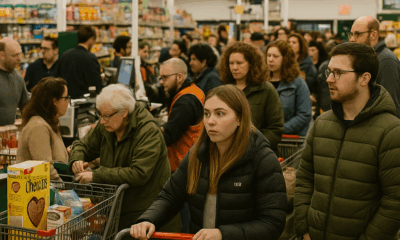Cybersecurity
Canadian Airline NorthSky Faces Cyberattack, Disrupting Online Services

Calgary, AB —
NorthSky Airlines, Canada’s second-largest air carrier, experienced a major cybersecurity incident last month that disrupted access to its mobile app and website, while prompting a swift internal response to safeguard sensitive systems and passenger data.
The disruption began on Friday, June 13, when users began reporting issues accessing NorthSky’s digital platforms. In a same-day statement, the Calgary-based airline confirmed it was responding to a cybersecurity breach that affected its internal systems. The company activated specialized response teams and immediately began coordinating with law enforcement and Transport Canada.
While online services were impacted, NorthSky emphasized that flight operations remained safe and uninterrupted throughout the incident. The airline advised customers to exercise caution with personal information but did not confirm whether any data had been accessed or stolen.
As of Saturday, June 14, NorthSky had not disclosed the nature of the attack—whether it involved ransomware, data theft, or another method—but stated that forensic investigations were underway. The airline pledged transparency and frequent updates as its teams worked to restore normal operations.
By the following day, access to the mobile app and website had largely been restored, though the company cautioned users that intermittent issues could persist while backend repairs continued. NorthSky continued to reassure travelers that safety and operational continuity were its top priorities.
In a detailed update released June 18, the airline stated that it had made “significant progress” in securing its digital infrastructure and had enlisted global cybersecurity and forensic firms to assist in the investigation. While the full scope of the breach had not yet been determined, NorthSky reaffirmed its commitment to protecting the personal data of its passengers and employees.
NorthSky also confirmed that it was in full compliance with regulatory requirements and remained in active coordination with national authorities. No flights were canceled or delayed due to the cyberattack, a testament to the company’s crisis response and operational resilience.
Despite the airline’s ongoing transparency, it has yet to confirm whether the attackers stole data, issued ransom demands, or represented a nation-state threat. The lack of technical disclosure has left some questions unanswered regarding the attack’s origin and impact.
Still, NorthSky’s response—including timely communication, consistent public updates, and partnerships with cybersecurity experts—has been credited with helping preserve trust during the disruption.
Headquartered in Calgary, NorthSky Airlines operates domestic and international passenger and cargo routes, and is currently ranked among the top ten airlines in North America by flight volume.
The investigation into the incident remains active.
Watching the perimeter — and what slips past it. — Ayaan Chowdhury
ODTN News’ Mira Evans contributed to this report.
Cybersecurity
Transit Screens Flash “TAKEOVER INCOMING,” Prompting Brief Panic Across Toronto

TORONTO, ON —
November 17, 2025 — Toronto commuters were startled this morning when digital screens at several bus and train terminals suddenly displayed the phrase “TAKEOVER INCOMING” before flickering off. The message appeared citywide and remained visible for approximately 30 seconds, long enough to trigger confusion and brief panic among riders trying to get to work.
Reports came in from Union Station, Bloor-Yonge, St. George, and multiple streetcar hubs where commuters were seen backing away from platforms, hesitating to board vehicles, and crowding near exits. Some riders described the moment as “unnerving,” citing the message’s abrupt appearance and ominous wording.
siberX Transit Systems (STS) quickly issued a statement downplaying the event, calling it a “momentary visual glitch”and insisting that all systems remained stable throughout the incident. STS emphasized that no service interruptions occurred and that there was “no evidence of a breach or external interference.”
“We want to reassure the public that operations are running normally,” the statement read. “This appears to be a display malfunction, and we are reviewing the logs to confirm the cause.”
Despite the calm messaging from STS, cybersecurity specialists tell ODTN News that any synchronized system abnormality, especially across multiple stations, warrants a closer look. One expert noted that even a brief, unexplained message suggests that either a central display controller malfunctioned or an unauthorized process momentarily pushed content to the screens.
City officials have requested a full technical review but have not issued further comment.
For now, transit continues to operate without interruption. Still, many riders remain uneasy, and social media is circulating photos and videos of the anomaly as the investigation unfolds.
ODTN News will continue tracking this incident and provide updates as more information becomes available.
Watching the perimeter — and what slips past it. — Ayaan Chowdhury
Cybersecurity
Experts Warn of ‘Silent Blackouts’ as Cyber Disruptions Test Toronto’s Digital Resilience

November 4, 2025 — The lights never went out…but everything else did.
This week’s wave of unexplained digital disruptions across major Canadian institutions has reignited debate about the country’s readiness for a large-scale cyber event.
From interrupted financial transactions to delayed hospital systems and transit slowdowns, the pattern was clear: infrastructure that once seemed independent is now woven together by code, contracts, and convenience. And when one thread snaps, the entire web shakes.
Cybersecurity analysts say the latest incident — which affected multiple public and private networks across the Greater Toronto Area — mirrors a growing international trend: attacks that target not just systems, but trust itself.
“We’re seeing adversaries blend automation, AI, and social manipulation,” said a former federal cyber advisor. “They don’t just want to lock your files — they want to shape your perception of reality.”
Experts note that the recent disruptions followed a familiar playbook. Early signs pointed to a compromise of shared vendor infrastructure, allowing attackers to quietly move between municipal, healthcare, and financial networks. While no single system fully collapsed, the cumulative effect was chaos, uncertainty that spread faster than malware.
Some officials privately compare the event to hybrid operations seen abroad, where cyberattacks are paired with misinformation to destabilize public confidence. AI-generated videos and fabricated emergency alerts reportedly circulated during the height of the disruption, adding confusion to an already fragile information environment.
“The scariest part wasn’t the outage,” said one Toronto hospital administrator who requested anonymity. “It was not knowing what was real. Patients were calling about fake news stories that we couldn’t even confirm or deny fast enough.”
While no group has claimed responsibility, digital forensics suggest the use of adaptive malware capable of rerouting attacks once defenders responded — a level of sophistication more often associated with state-backed operations than criminal gangs.
The incident comes amid broader concerns about Canada’s cyber resilience. A recent Public Safety report warned that critical sectors — healthcare, energy, and finance — are increasingly dependent on third-party service providers, many of which lack robust cybersecurity standards.
For Canadians, the disruptions were mostly invisible: a few frozen apps, some delayed services, and temporary confusion online. But experts say it could have been worse — and next time, it might be.
“It’s a warning shot,” said a threat intelligence researcher based in Montreal. “The systems held, barely. But the attackers learned how we respond. They’ll come back smarter.”
Officials have not confirmed the full scope of the incident, but investigations continue across multiple jurisdictions.
If nothing else, this week’s events made one thing clear: Canada’s next major crisis may not start with a storm or a siren — it may start with silence.
Watching the perimeter — and what slips past it. — Ayaan Chowdhury
Cybersecurity
Group Arrested for Sophisticated AI Cyberattack: Government Remains Tight-lipped

Washington, DC —
In a sweeping operation, federal authorities arrested a group of individuals on charges related to a highly sophisticated AI-driven cyberattack that crippled several key infrastructure systems across the United States. The attack, which unfolded over the course of several months, has been described by experts as one of the most advanced forms of cyber warfare ever seen.
The suspects, identified only by their aliases—“Shadow42,” “RedWolf,” “BlackKnight,” and “Pixel” in the official report—were apprehended in a coordinated raid carried out by the Federal Cybersecurity Task Force, a joint initiative between several government agencies. They are believed to have masterminded the attack using cutting-edge artificial intelligence algorithms capable of bypassing traditional security systems.
The Attack Unfolds
The cyberattack was first detected by the Department of Cybersecurity and Infrastructure Security (DCIS) in late August, when unusual data patterns were spotted across major government networks. The hackers used AI-powered tools that could autonomously adapt to defense mechanisms, shifting tactics in real-time and avoiding detection by conventional security measures. Experts have noted that the sophistication of the tools used was on par with those typically seen in state-sponsored cyber operations.
The attack primarily targeted critical systems in healthcare, transportation, and financial sectors, leading to disruptions that left many citizens facing delays in accessing essential services. The attackers appeared to use AI to automate data exfiltration and disrupt systems without triggering any major alarms. In some instances, the AI algorithms reportedly altered data in transit, making it difficult to trace the attack’s origins.
Government Keeps Details Under Wraps
Despite the arrests, the federal government has been remarkably quiet on the details of the attack. In a statement, the Department of Justice confirmed the arrests but has refrained from commenting on the specifics of the cyberattack or the identities of the organizations that may have been involved.
A spokesperson for the government, who spoke on the condition of anonymity, hinted that the attackers had connections to a network of highly skilled individuals but declined to provide further information. “This was a highly sophisticated operation that required immense resources and expertise,” the spokesperson said. “At this stage, we are still investigating the full extent of the operation.“
Several government officials have also raised concerns about the use of AI in cyberattacks, calling it a game-changer in the world of cybersecurity. “This incident highlights the growing threat of AI-powered attacks, which can outsmart our defences at every level,” said an anonymous senior cybersecurity official.
The Role of AI in the Attack
The AI algorithms used in the attack were allegedly designed to mimic human behavior, making it extremely difficult to distinguish between legitimate and malicious activities. It was reported that the AI systems were able to “learn” from their interactions with security protocols, continuously improving and finding new ways to exploit vulnerabilities.
Some experts believe that the technology used by the attackers could revolutionize the field of cybercrime, with AI becoming a key tool in the arsenal of future cyber criminals. The rapid adaptability and precision of AI-driven attacks have raised concerns about the future of cybersecurity and the potential for AI to be weaponized in ways never seen before.
What’s Next for the Alleged Attackers?
As the investigation continues, law enforcement agencies are reportedly working to uncover the full scope of the operation. Sources suggest that the group may have had international connections, but the full extent of their network remains unclear.
The arrested individuals are expected to face a range of charges, including cyberterrorism, identity theft, and espionage. If convicted, they could face significant prison sentences. Legal experts have noted that the case may set a precedent for how AI-related cybercrimes are prosecuted in the future.
In the meantime, the public remains largely in the dark about the full scale of the attack, with the government keeping many details under wraps. While some have questioned the transparency of the investigation, others are urging caution, acknowledging the sensitive nature of the incident.
As the investigation progresses, experts warn that AI-driven cyberattacks may become an increasingly prevalent threat, potentially changing the landscape of cybersecurity forever.
Watching the perimeter — and what slips past it. — Ayaan Chowdhury
-

 Retail Watch4 months ago
Retail Watch4 months agoCalgary Small Business Hit by Sudden Payment Outage, Sparks Cybersecurity Concerns
-

 Public5 months ago
Public5 months agoReddit Thread Over ‘Inventory Drift’ Surges as Canadians Vent Over Retail Glitches
-

 Business8 months ago
Business8 months agoCanadian Software Vendor Breach Exposes Cloud Environments Across Energy Sector
-

 Retail Watch5 months ago
Retail Watch5 months agoUnderstaffed and overwhelmed, IT teams face rising pressure as retail digitization accelerates
-

 Business4 months ago
Business4 months agoAre Canadian Companies Learning from Global Cyber Attacks? Insider Insights into the Secret Downfall of Canadian Businesses
-

 Politics4 months ago
Politics4 months agoNationwide Government System Outage Paralyzes Public Services
-

 Politics5 months ago
Politics5 months agoCanada, ESB Sign Digital Security Pact to Counter Global Telecom Threats
-

 Business4 months ago
Business4 months agoInsurance Without a Safety Net? Canadian Firms Face Premium Hikes Amid Cyber Liability Crisis

















